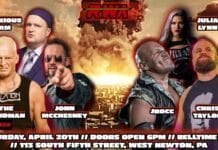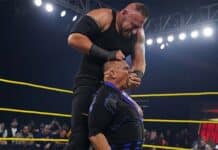It was more than five years ago that WWE management picked their corporate star, the competitor that they envisioned would be the perfect representative for the company’s global publicly traded brand. Roman Reigns, the cousin of Hollywood mega star and WWE alumni, The Rock, was the chosen champion for the future.
Roman’s rise to stardom wasn’t without its speed bumps, mostly put there by the way WWE brass decided to present him to the audience, at one point he was portrayed with a tone of defiance. The wrestling public would take what Vince McMahon gave them and like it. The infamous “not a good guy, not a bad guy, the guy” promo was more or less Vince’s way to tell the audience that he determines the WWE path, not them.
In truth, Vince does has a lot of that power, at least to some level. As I’ve written before, the WWE is the walmart of professional wrestling, it’s relatively cheap and the most accessible product with the most brand identity in the United States. It’s been twenty years since the Monday Night Wars, there’s an entire generation of fans that only know the narrative of WCW through the WWE lens, and without experiencing it first-hand, there’s an entire demographic that doesn’t realize that there really was a time when WWE wasn’t the only major sports entertainment show in America. The point being, the general public associates pro wrestling with the WWE, which is partially why the company can be traded on the stock market in the first place.
So, Vince planned to use that leverage for his ideal pick to replace John Cena as the top draw in the organization. The flip side of the modern era, where WWE is more or less known as pro wrestling in the United States is that through the company’s own documentary productions, it’s directly acknowledged that the product is only entertainment and thus that there are decision-makers behind the scenes. As a result, for the first time in the history of the sport, the heat for a booking decision doesn’t go on the heel to build for the baby face to get revenge, but rather the heat is toward the company for making the decisions. It’s really a unique dichotomy that hasn’t been mastered by any of the big league organizations yet.
The writing team thought that positioning Roman Reigns to simply run over the competition, including Daniel Bryan, who was still one of the most over performers on the roster before a three-year absence due to injury in 2015, was the way to make him the next Cena. First, the goal to make anyone the next John Cena is really an unfair situation, especially because the company appeared to specifically try to shoehorn him into the Cena role when it just didn’t fit him, which isn’t to say that Roman can’t be a top guy. Cena got over to the level he did because he found a formula that worked for him and made the most of it. If Reigns can reach that level remains to be seen, but he must be allowed to find himself to be able to maximize his potential. The cookie cutter approach is rarely successful in professional wrestling.
As I’ve discussed before, when Roman was scripted for lame attempts at comedy, it was completely counterproductive to what could get him over. Sometimes the simplest presentation is the best method so Roman as the Samoan monster that will fight any challengers was probably the most effective portrayal since the start. It’s disappointing that it took the WWE four years to realize that. Utilizing his look, size, and intensity was all that was needed and what he could do best. The attempted witty lines only made him look foolish and uncomfortable on live TV, which the viewers could see on screen.
It was only after a pandemic shut down most of the world and ratings dipped drastically that management decided to go through with the heel turn, which has already given Roman the best work of his career. Granted, last year when Reigns returned from a recurrence of leukemia, it provided the WWE with the opportunity to tell a story in the ring that transcended the realm of sports entertainment and could connect with the audience as a real-life comeback story, but he was booked for a mid-card match with Drew McIntyre at the time instead of the title picture. When COVID precautions put him on the sidelines because of his medical history, the heel turn was probably the only fresh coat of paint the writing team could put on the Reigns project. Management made so many mistakes with how they shoehorned him ahead of guys like Bryan and Braun over the years that the rejection of Roman was more hostility toward the company, not the actual performer. It’s disappointing that Reigns was booked for more hurdles than in scenarios that could help him evolve as a character. A prime example was the Elimination Chamber match a few years ago where Braun eliminated most of the competition, but Roman won the match to show that “Roman is really strong” but the modern audience can see through the subtext of the angle.
Again, it took the office over four years to realize their shoehorn plan wasn’t going to work. The main example I’ve said before is, if Rocky Maivia didn’t turn heel,would The Rock have eventually gotten over as one of the biggest baby faces in the history of the industry? The heel turn allowed The Rock to evolve as a character and that was part of the process that made him such a major star.
The bottom line is, the WWE invested years of time and promotion into the Roman Reigns project so if they want it to pay off then they have to spotlight his strengths and camouflage any weaknesses.
Roman isn’t necessarily the best on the mic? So, they gave arguably the best talker in the business with Paul Heyman, and there’s nothing wrong with that. If anything, aside from the promos, Heyman as a character brings a certain level of credibility to the heel turn. Reigns is a Samoan monster so put him in scenarios that highlight that aspect of his work. As a stand alone match, Roman vs. Jey Uso wasn’t anything spectacular, especially for the main event of a pay-per-view, but considering that a network subscription is only $10 a month, there’s more flexibility with what could be considered a worthy PPV main event. The more important point is how the segment was presented and it gives WWE’s state-of-the-art production team the footage to edit video packages that spotlight Roman as a top level heel. The visual of Reigns viciously punching Jey and then standing over him without remorse is much more valuable than any particular bell-to-bell action at the pay-per-view.
The Rock recently mentioned that he would consider an eventual match with Roman, which would obviously be a big money match and perhaps the “passing of the torch” WWE tried to manufacture with other opponents in the past. The Rock/Roman angle basically writes itself and would probably generate some of the most compelling television of the modern era. However, The Rock’s movie career is worth literally hundreds of millions of dollars so much of it would depend on the schedule and the risk involved in a WWE return. That being said, The Rock vs. Roman Reigns at Wrestlemania 37 would definitely get the entertainment world talking about the WWE again, which would be a major benefit to the company, especially with the slump from the pandemic era. Either way, it will be interesting to see how Reigns continues to evolve as a character and if he can reach the status as the top draw because he has finally been put in the position to make the most possible of the push from the company.
What do you think? Comment below with your thoughts, opinions, feedback and anything else that was raised.
Until next week
-Jim LaMotta
E mail [email protected] | You can follow me on Twitter @jimlamotta







